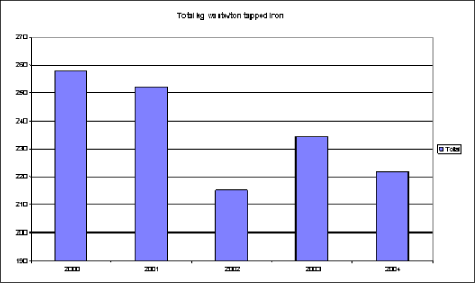|
Affaldsminimering i støberi- og maskinindustrien Summary and conclusionsIron foundry makes a fortune on waste During the last four years, Vald. Birn A/S, the largest iron foundry in Northern Europe, has made an extraordinary effort to reduce the quantities of waste by testing new techniques for recovery of resources that otherwise are expensive to purchase or dispose of. At the same time, Vald. Birn A/S has carried out a series of workshops together with KPMG with the purpose of highlighting the employees' own ideas for waste reduction, and it has turned out that their ideas were worth a fortune. "Background and purpose" The project "Waste reduction within the foundry and machine industry" was financed by Perspektivpuljen through the Danish Environmental Protection Agency's programme for clean products. The foundry industry outweighs many other industries in the waste statistics, and in year 2000, Vald. Birn A/S disposed of approx. 22,000 tonnes of waste. The purpose of the project was to analyse the possibilities of waste reduction from selected waste fractions within the foundry and machine industry through recycling a large part of the waste from the production processes for internal use and by reducing overall waste quantities in general. Vald. Birn A/S took the initiative to achieve waste reductions partly through developing and testing new technologies, and partly through involving and training employees to identify and promote new improvement ideas. "Survey" Three technical pilot projects were launched. A programme was also launched on involvement of employees through training and changing their attitudes so they regard waste as a loss for the company and
bring forward their own ideas to recycle the waste in the production process. The purpose of the technical pilot projects was to test whether the following ideas could be feasible:
The main conclusions of the project were:
By carrying out the pilot projects as well as involving the employees and their ideas, Vald. Birn A/S has achieved a reduction in waste per tonne tapped iron of 14% which corresponds to 36 kg/tonne tapped iron. For the quantity of tapped iron in 2004, this results in a reduction of 3,215 tonne waste. Based on Vald. Birn A/S' waste disposal prices in 2004, the above reduction in waste corresponds to a saving of DKK 1.1 million. The value of the increased recycling ratio achieved in the same period (from 72% to 97%) has not been included, which makes the waste disposal significantly cheaper for certain fractions. If we assume that the reduced quantity of waste replaces corresponding repurchase of raw materials, the saving amounts to DKK 1.3 million. All in all, an estimated yearly saving of DKK 2.5 million is achieved on solid waste. In addition, there will be the savings from implementation of the central KSM unit in the machine shop, which is expected to amount to DKK 1 million yearly, when the unit is fully developed. If the effort is compared to the reduction in quantity of scrapped clay-bound moulding sand, a 15% reduction has been achieved for these fractions. If this result is extended to Denmark as a whole, where Støberiforeningen (a Danish association of foundries) estimates that 60-70,000 tonnes clay-bound core sand are scrapped by the foundry industry, this corresponds to a possible waste reduction of 9-10,500 tonnes per year nationwide.
Project results The tests of clay and coal recovery from filters in the sand towers show that the planned technique with vibration over a Trenso separation table cannot meet the requirements for separation of particles in the requested grain size. The tests performed gave a 40% recovery of the potential, but the uncertainty in the test runs was too great. Vald. Birn A/S expects to find other technical solutions. The test with demolition of core scrap and addition of new core sand in small quantities turned out to be a success. 99% of the core scrap demolished could be added as new sand, and tests were performed where up to 7% addition of core sand did not cause production or quality problems. At the end of the project, approx. 5 tonnes of core scrap per week were recovered, corresponding to approx. 200 tonnes per year and Vald. Birn A/S anticipates being capable of increasing this quantity. Setting up a central unit for handling and maintenance of cooling lubricants has turned out to work very satisfactorily. At the end of the project, three salvaging machines were linked to the unit and the life time of the cooling lubricants had been extended from approx. two to nine months, leading to an approx. 75% saving on purchase and disposal of cooling lubricants. At the same time, it was stated that the operation of the unit required fewer man-hours and machine stops for cleaning and maintenance. The workshops for training and working with change of employee attitudes so that they regard waste as a loss for Vald. Birn A/S were very successful. Listening to the employees' ideas in respect of waste reduction and recovery of waste in the production process yielded great results. A visible result is the development in the quantity of sand on the floor along the seven production lines. The sand is removed by the cleaning team by means of a central aspirator unit. After the cleaning team had focused on where the aspirator was used the most, they documented it via photos and the repair team is now capable of setting priority for work during the weekend. From having to vacuum 27 kg per tonne tapped iron in 2000, the team now only vacuums 19 kg per tonne tapped iron. "Other sources": www.birn.dk www.kpmg.dk
|
